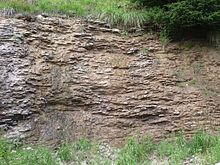General reports
The Allgäu layers or Allgäu formation are a geological formation of the Lower Jura , which is named after its frequent occurrence in the Allgäu Alps . The Allgäu layers belong to the Allgäu ceiling . The rocks of the Allgäu layer appear only on steep slopes furrowed by erosion channels - where the earth has slipped or could not hold up from the ground - and sharp ridges. These rock layers form the so-called "Allgäu grass mountains". The Allgäu layers are an important basis for alpine farming: grassland could form on them, which is of existential importance for cattle breeding.
Stratigraphic classification
The layers were deposited in the Lias and Dogger in a relatively closed sedimentation basin (basin facies of the Jura). Regionally, the Allgäu layers reach a thickness of up to 1500 meters and are often correlated with the Lias spotted marl , but they are more diverse than this. The sequence of strata occurs in reduced thickness outside of the Allgäu in other areas of the Northern Limestone Alps , in the Bajuvarikum and partly in the Tirolikum and Juvavikum. In the Lienz Dolomites, which geologically belong to the Central Eastern Alps , the Allgäu layers only comprise the Liassic part with a thickness of 300 meters, while the younger Jura deposits are formed by red tuber limestone.
Petrographic training

In the Allgäu strata, in addition to the dominant calcareous and clayey marls , pure limestone and pebble inclusions as well as black, manganese-containing shale clays are involved in the layer structure. Sandy interventions can be observed locally on the northern edge of the Alps.
The Allgäu layers were mainly formed in the Lower Jurassic about 200 to 157 million years ago. In the western section of the Limestone Alps, there are three sections:
- Older allgäu layers made from red base limestone of the deep Lias , marly limestone, spotted marl and silica limestone ,
- Middle Allgäu layers of schisty marls, marl limestone and manganese slate of the lower Toarc (higher Lias),
- Younger Allgäu layers with spotted marl, marl limestone and limestone from the upper Toarc to Callov (Lias to Dogger).
Fossils
Fossils found in the Allgäu layers enable a reconstruction of the thickness of this layer sequence. In the avalanche rubble at the foot of a mountain of spotted marl, remains of creatures from the Jurassic Sea can be found that are petrified in the layer. The fossils found include arm gills , snails ( Pleurotomaria ), mussels ( Inoceramus ), belemnite rusts , stalk limbs of sea lilies and some vertebrate remains (mostly fish scales, teeth and vertebrae). The most common fossils, however, are ammonites .
Individual evidence
- ^ U. Haas & U. Teipel: Allgäu formation , In: LithoLex - online database. Federal Institute for Geosciences and Natural Resources, Hanover 2015, accessed on February 9, 2016
- ^ A b Günter Möbus: Geology of the Alps . Sven von Loga, Cologne 1997, ISBN 3-87361-249-6 , p. 145.
- ^ Herbert Scholz: Building and Becoming the Allgäu Landscape. Between Lech and Lake Constance - a southern German geological and landscape history. 2nd edition, Stuttgart 1995, Schweizbart, ISBN 3-510-65165-0 , p. 48.
- ^ Günter Möbus: Geology of the Alps . Sven von Loga, Cologne 1997, ISBN 3-87361-249-6 , p. 212.
- ^ Klaus Doben and Hans Risch: Northern Limestone Alps (Eastern Alps) . In: Bayerisches Geologisches Landesamt (ed.): Geological map of Bavaria 1: 500,000: Explanation , 4th edition, Munich 1996, pp. 225–227
- ^ Herbert Scholz: Building and Becoming the Allgäu Landscape. Between Lech and Lake Constance - a southern German geological and landscape history. 2nd edition, Stuttgart 1995, Schweizbart, ISBN 3-510-65165-0 , p. 50f.
literature
- R. Oberhauser et al .: The geological structure of Austria, Geologische Bundesanstalt (Ed.), Springer-Verlag Wien - New York 1980, pp. 29–39, 228f., 416.
- P. Schmidt-Tomé: The Alpine region. In: Bayerisches Geologisches Landesamt (Hrsg.): Geological map of Bavaria 1: 500,000: Explanation , 2nd edition, Munich 1964, pp. 244-296.